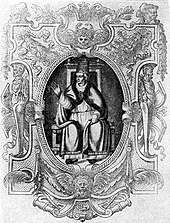Pope Clement II
This article has multiple issues. Please help improve it or discuss these issues on the talk page. (Learn how and when to remove these messages)
|
Pope Clement II | |
|---|---|
 | |
| Papacy began | 25 December 1046 |
| Papacy ended | 9 October 1047 |
| Predecessor | Gregory VI |
| Successor | Benedict IX |
| Personal details | |
| Born | Suidger von Morsleben |
| Died | 9 October 1047 Pesaro, Papal States, Holy Roman Empire |
| Other popes named Clement | |
Pope Clement II (Template:Lang-la; born Suidger von Morsleben; died 9 October 1047), was Pope from 25 December 1046 until his death in 1047. He was the first in a series of reform-minded popes from Germany.
Life
Born in Hornburg, Lower Saxony, Germany, he was the son of Count Konrad of Morsleben and Hornburg and his wife Amulrad.
In 1040, he became Bishop of Bamberg. In 1046, he accompanied King Henry III on his campaign to Italy and in December, participated in the Council of Sutri, which deposed former Popes Benedict IX and Sylvester III and persuaded Pope Gregory VI to resign. King Henry nominated Suidger for the papacy and the council elected him. Suidger took the name Clement II. Immediately after his election, King Henry and the new Pope moved to Rome, where Clement crowned Henry III as Holy Roman Emperor.
Clement II's short pontificate, starting with the Roman synod of 1047, initiated an improvement in the state of affairs within the Roman Church, particularly by enacting decrees against simony. A dispute for precedence among the Sees of Ravenna, Milan, and Aquileia was settled in favour of Ravenna.

Clement's election was later criticized by the reform party within the papal curia due to the royal involvement and the fact that the new Pope was already bishop of another diocese. Contrary to later practice, Clement kept his old see, governing both Rome and Bamberg simultaneously.
Clement accompanied the Emperor in a triumphal progress through southern Italy and placed Benevento under an interdict for refusing to open its gates to them. Proceeding with Henry to Germany, he canonized Wiborada, a nun of St. Gall, martyred by the Hungarians in 925. On his way back to Rome, he died near Pesaro on 9 October 1047.[1] His corpse was transferred back to Bamberg, which he had loved dearly, and interred in the western choir of the Bamberg Cathedral. His is the only tomb of a Pope north of the Alps.
A toxicologic examination of his remains in the mid-20th century confirmed centuries-old rumors that the Pope had been poisoned with lead sugar.[2] It is not clear, however, whether he was murdered or whether the lead sugar was used as medicine.
References
- ^ http://www2.fiu.edu/~mirandas/bios996-ii.htm#Morsleben
- ^ Specht W and Fischer K (1959). Vergiftungsnachweis an den Resten einer 900 Jahre alten Leiche. Arch. Kriminol., 124: 61–84. [Translation:Intoxication evidence in the remains of a 900-year-old corpse]
- Catholic Encyclopedia, "Pope Clement II" (1913).
